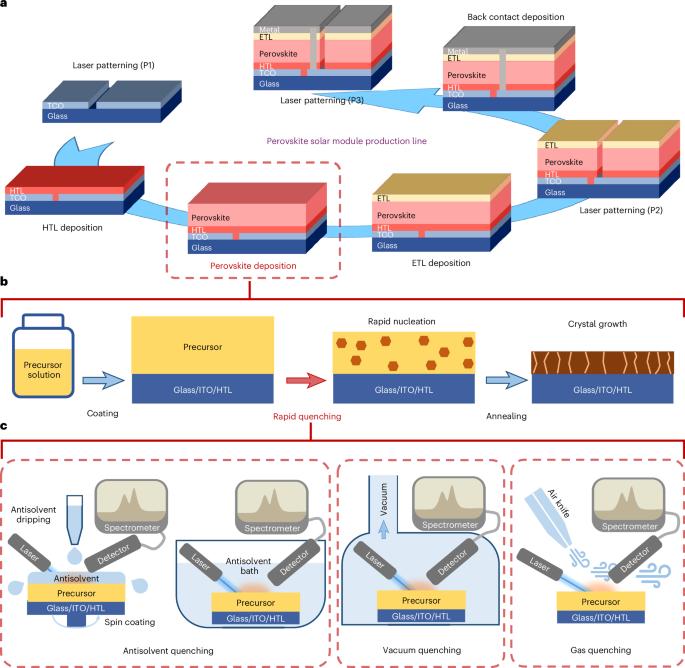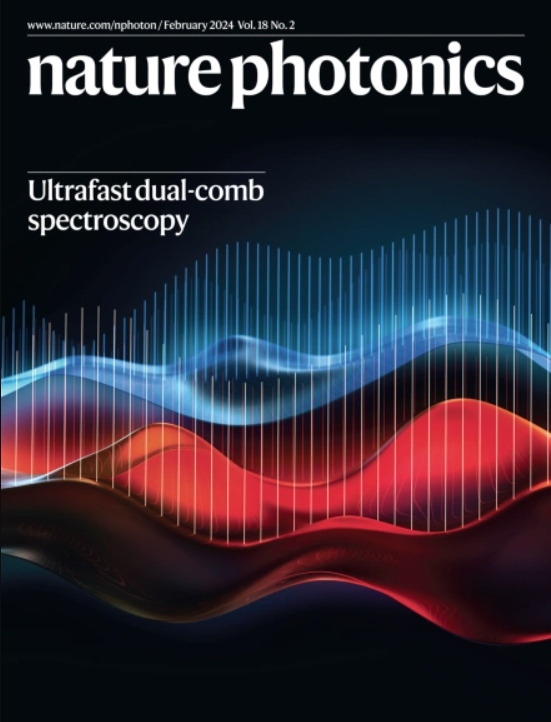钙钛矿太阳能组件的温控真空淬火,可规模化生产
IF 32.9
1区 物理与天体物理
Q1 OPTICS
引用次数: 0
摘要
钙钛矿太阳能电池(PSCs)表现出显著改善的性能和稳定性;然而,在扩大电池面积的同时保持高功率转换效率(PCE)和稳定性仍然是一个挑战。此外,钙钛矿的成核和生长对加工方法高度敏感,增加了大规模生产的复杂性。为了解决这些挑战,我们建立了一种温度控制的真空淬火方法,结合原位光致发光光谱法,在监测下制备钙钛矿薄膜。系统地研究了常用的淬火成核过程,揭示了抽速、溶剂体系和添加剂对真空淬火过程的影响。我们设法通过在真空淬火过程中降低温度来调节钙钛矿成核过程,从而扩大后处理的时间窗口,以获得高质量的大面积钙钛矿薄膜。由此产生的1.55 eV迷你模块在孔径面积为11.7 cm2的情况下实现了22.69%的PCE(认证孔径面积PCE为21.60%),而相应的PSC在1个太阳照射下在45°C连续工作3,500小时后保持了93%的初始效率。这种方法可以在刚性、柔性和弯曲基板上实现高质量、均匀和大面积的钙钛矿薄膜,证明了我们提高可再生PSC技术可扩展性的策略的可行性。本文章由计算机程序翻译,如有差异,请以英文原文为准。


Temperature-controlled vacuum quenching for perovskite solar modules towards scalable production
Perovskite solar cells (PSCs) exhibit substantially improved performance and stability; however, maintaining high power conversion efficiency (PCE) and stability while up-scaling cell areas remains challenging. Furthermore, perovskite nucleation and growth are highly sensitive to processing methods, increasing the complexity of large-scale production. To address these challenges, we establish a temperature-controlled vacuum quenching method combined with in situ photoluminescence spectrometry to fabricate perovskite films under monitoring. We systematically study the commonly used quenching nucleation processes and reveal the impact of the pumping speed, solvent system and additives on the vacuum quenching process. We manage to modulate the perovskite nucleation process by lowering the temperature during the vacuum quenching process, thereby broadening the time window for post-processing treatments to obtain high-quality large-area perovskite films. The resultant 1.55 eV mini-module achieves a PCE of 22.69% with an aperture area of 11.7 cm2 (and a certified aperture-area PCE of 21.60%), whereas the corresponding PSC maintained >93% of its initial efficiency after continuously operating at 45 °C for 3,500 h under 1 sun illumination. This approach enables high-quality, uniform and large-area perovskite films on rigid, flexible and curved substrates, demonstrating the feasibility of our strategy for improving the scalability of renewable PSC technology. A temperature-controlled vacuum quenching method enables the fabrication of perovskite solar modules with a power conversion efficiency of 22.69% and an area of 11.7 cm2, while the corresponding cells maintain over 93% of their initial efficiency after 3,500 h of operation.
求助全文
通过发布文献求助,成功后即可免费获取论文全文。
去求助
来源期刊

Nature Photonics
物理-光学
CiteScore
54.20
自引率
1.70%
发文量
158
审稿时长
12 months
期刊介绍:
Nature Photonics is a monthly journal dedicated to the scientific study and application of light, known as Photonics. It publishes top-quality, peer-reviewed research across all areas of light generation, manipulation, and detection.
The journal encompasses research into the fundamental properties of light and its interactions with matter, as well as the latest developments in optoelectronic devices and emerging photonics applications. Topics covered include lasers, LEDs, imaging, detectors, optoelectronic devices, quantum optics, biophotonics, optical data storage, spectroscopy, fiber optics, solar energy, displays, terahertz technology, nonlinear optics, plasmonics, nanophotonics, and X-rays.
In addition to research papers and review articles summarizing scientific findings in optoelectronics, Nature Photonics also features News and Views pieces and research highlights. It uniquely includes articles on the business aspects of the industry, such as technology commercialization and market analysis, offering a comprehensive perspective on the field.
 求助内容:
求助内容: 应助结果提醒方式:
应助结果提醒方式:


